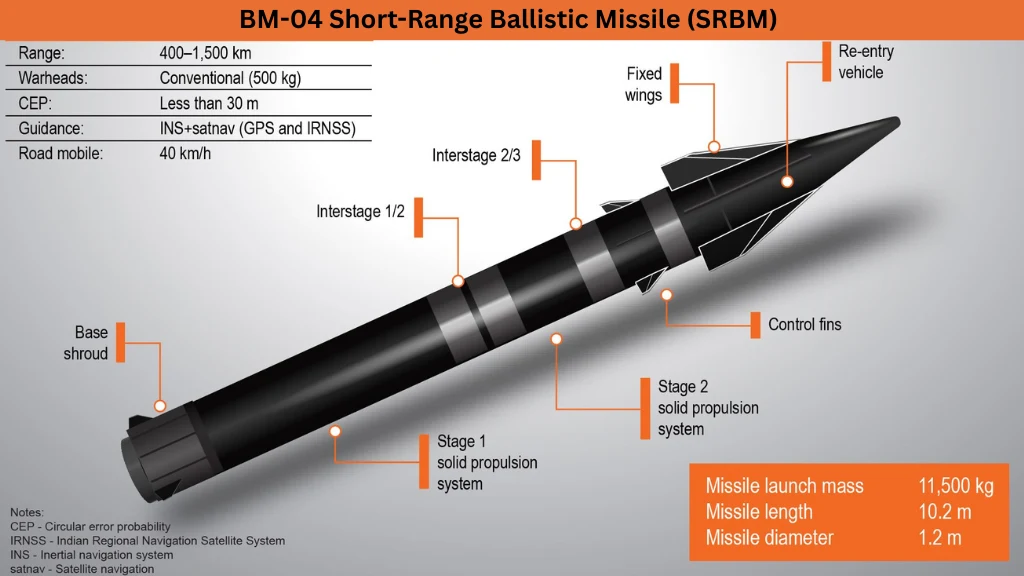Short-range ballistic missiles (SRBMS) are increasingly becoming key elements in modern military arsenals, especially in regions with high geopolitical tensions. Recently, India unveiled its next-generation SRBM, the BM-04, at a defence exhibition in Hyderabad. This launch highlights the significant advancements in missile technology, which could shape the future of defence strategies in the region. In this blog, we will dive into the key features of SRBMS, explore the specifications of the BM-04, and discuss its strategic implications.
What Exactly Are Short-Range Ballistic Missiles (SRBMS)?
Short-range ballistic missiles (SRBMS) are designed to deliver warheads across distances ranging from 400 to 1,500 kilometres (about 249 to 932 miles). They are mainly used for rapid-response missions and are ideal for regional conflicts. Unlike cruise missiles, which maintain a consistent flight path, SRBMS follow a ballistic trajectory, meaning they use gravity to guide their descent towards a target. This distinction makes SRBMS an important asset for military forces looking for quick, precise strikes.
Key Features of SRBMS
Let’s take a closer look at some of the defining characteristics of SRBMS:
- Range: One of the main advantages of SRBMS is their range. Designed to deliver powerful strikes within a specific region, SRBMS are perfect for immediate operational use, especially in volatile areas.
- Payload: These missiles are versatile in terms of payloads. They can carry a variety of warheads, including conventional explosives or nuclear payloads, depending on the mission at hand.
- Guidance Systems: Modern SRBMs use advanced guidance systems. This includes technologies like inertial navigation systems and satellite guidance, which significantly improve their targeting accuracy.
The BM-04: India’s Cutting-Edge SRBM
Specifications of the BM-04
The BM-04, developed by India’s Defence Research and Development Organisation (DRDO), is a next-generation missile with impressive specifications. Here are the key details that set it apart:
- Dimensions: Measuring 10.2 meters in length and 1.2 meters in diameter, the BM-04 weighs around 11,500 kg. These dimensions give it a solid presence in India’s missile defence capabilities.
- Propulsion System: The missile uses a two-stage solid-fuel propulsion system. This design helps it achieve high speeds and ensures that the missile remains reliable in various conditions.
- Range and Payload: The BM-04 can strike targets up to 1,500 km away. It can carry a 500 kg conventional payload, making it an effective option for taking out key targets.
- Accuracy: With an impressive circular error probability (CEP) of just 30 meters, the BM-04 is highly accurate, ensuring that it can hit critical targets with minimal deviation.
- Transport and Launch: The missile is deployed via a six-wheel transport erector launcher (TEL), which allows for rapid mobility and quick deployment in various terrains.
The BM-04 is also designed for cauterization. This means it can be pre-loaded with warheads and prepared for launch quickly, further improving its readiness.
Technological Advancements and Future Upgrades
One of the key strengths of the BM-04 lies in its ability to evolve. DRDO has incorporated artificial intelligence (AI) into the missile’s development, ensuring that it can be easily upgraded to counter emerging threats. This ability to adapt and enhance the missile’s capabilities ensures it will remain a key deterrent for years to come.
Strategic Importance of the BM-04
Enhancing Conventional Counterforce Capability
The BM-04 strengthens India’s conventional counterforce capabilities. Unlike older systems, the BM-04 is designed for conventional strikes. This means it can target critical military infrastructure without escalating the situation to nuclear conflict. This shift is significant, especially in a region where nuclear deterrence plays a key role in defence strategies.
Targeting Key Infrastructure
The BM-04 is particularly effective against critical infrastructure, including:
- Air bases
- Command-and-control centres
- Ammunition storage
- Surface-to-air missile systems
Thanks to its speed and precision, it can effectively engage time-sensitive targets like mobile platforms and military vehicles, which require swift action to neutralize.
A Shift Towards Pre-emptive Strikes
The BM-04 also signals a potential shift in India’s military doctrine towards pre-emptive strikes. With its ability to conduct precision strikes, India can target adversaries’ conventional forces without escalating to nuclear warfare. This capability allows India to act decisively while maintaining a measured approach to conflict.
Operational Dynamics in South Asia
The BM-04’s role extends beyond just its technical specifications. It also offers strategic advantages in the South Asian context. By positioning the BM-04 deep within Indian territory, India can deploy its missile regiments in a way that complicates efforts by adversaries like Pakistan to target them. For example, placing the missile near India’s XXI Corps headquarters allows it to strike targets in Pakistan while minimizing the risk of retaliation.
Regional Implications and Risks
Potential for Escalation
While the BM-04 strengthens India’s defence capabilities, it also raises concerns about regional escalation. The introduction of this advanced missile system, coupled with India’s growing conventional rocket force, could lead to more aggressive military strategies in the region. This shift might increase the risk of conflicts that could spiral out of control.
Impact on Regional Stability
The introduction of the BM-04 does not necessarily destabilize the region, but it does alter the strategic balance. As India diversifies its missile forces, the potential for initiating conflicts, whether conventional or sub-conventional, becomes more likely. The combination of advanced missile technology and evolving military doctrines suggests that India is preparing for a range of conflict scenarios, even under the shadow of nuclear deterrence.
Conclusion
The unveiling of the BM-04 marks an important step in India’s defence capabilities. This next-generation SRBM combines cutting-edge technology with a strategic vision, enhancing India’s ability to respond effectively to regional challenges.
As the security landscape in South Asia continues to evolve, understanding the role and capabilities of missiles like the BM-04 is crucial. While the missile strengthens India’s conventional forces, it also raises important questions about military escalation and the delicate balance of power in the region.
Learn more at DefenceNewsIndia.in – your trusted source for updates on India’s defense, aerospace, and strategic innovations.
